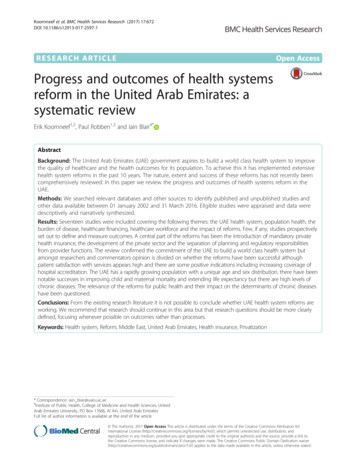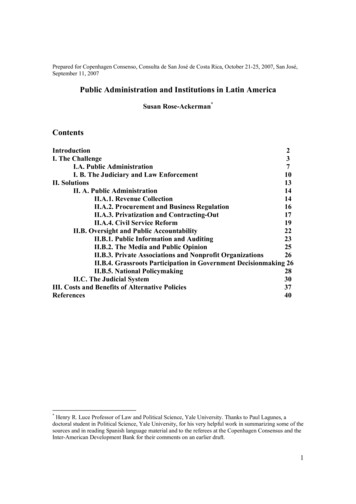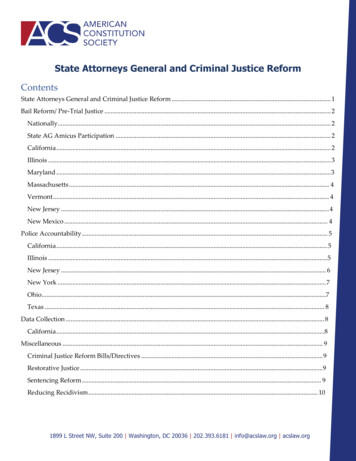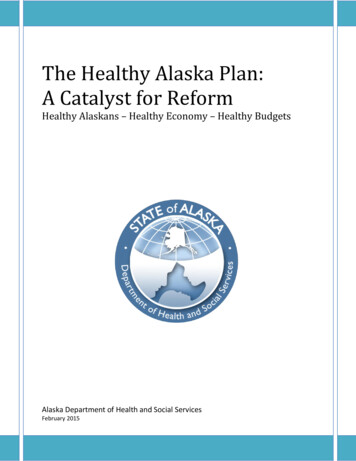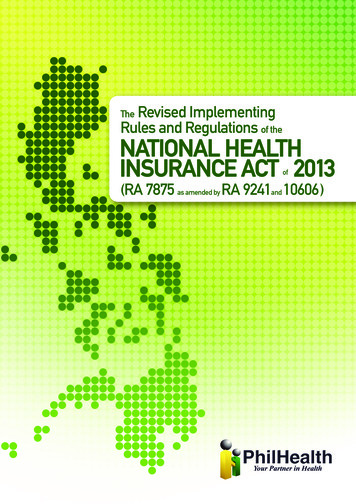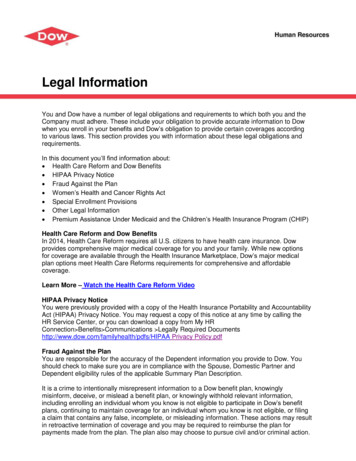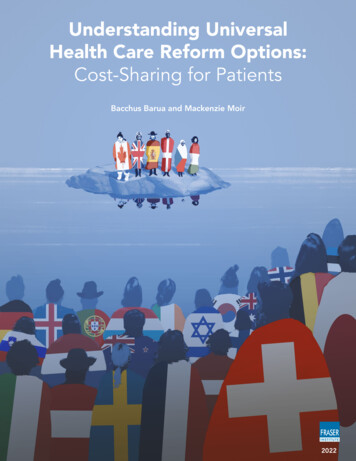
Transcription
Understanding UniversalHealth Care Reform Options:Cost-Sharing for PatientsBacchus Barua and Mackenzie Moir2022
2022 Fraser InstituteUnderstanding UniversalHealth Care Reform OptionsCost-Sharing for Patientsby Bacchus Barua and Mackenzie Moirfraserinstitute.org
fraserinstitute.org
ContentsExecutive Summary / iIntroduction / 11 Health Insurance, Moral Hazard, and Cost-Sharing—a Theoretical Framework / 32 Cost-Sharing by Patients in High-Income Countries with Universal Health Care / 9Australia / 16New Zealand / 32Belgium / 19Norway / 34France / 24Sweden / 36Netherlands / 28Switzerland / 393 Empirical Evidence on the Possible Consequences of Cost-Sharing / 434 Exploring the Correlation among Cost-Sharing, Wait Times,and Financial Barriers to Medical Care / 575 Cost-sharing and the Canada Health Act / 65Summary and Conclusion / 68Appendix 1—Conditions and Benefits for Chronically Ill Status in Belgium / 70Appendix 2—Personal Contributions for Care in the Netherlands / 71Appendix 3—Lists of Countries Ranked in the Three Reports Used in this Study / 72References / 73About the Authors / 97About the Fraser Institute / 101Acknowledgments / 98Editorial Advisory Board / 102Publishing Information / 99Purpose, Funding, and Independence / 100Supporting the Fraser Institute / 100fraserinstitute.org
fraserinstitute.org
Barua and Moir Understanding Universal Health Care Reform Options—Cost-Sharing for Patients iExecutive SummaryComprehensive measures of performance indicate that Canada routinely lagsbehind its international peers on key metrics of how its health-care system performs—despite ranking amongst the most expensive universal health-care systemsin the developed world. It is, therefore, unsurprising that a growing proportionof Canadians seem open to the possibility of fundamental reform of health care inCanada. However, major hurdles exist as a result of faulty perceptions about howother countries with universal health-care insurance coverage provide and financetheir health-care systems.This study—the third in the series, Understanding Universal Health Care ReformOptions—documents the presence of mechanisms for cost-sharing by patients in28 universal health-care systems; and evaluates the feasibility and desirability ofintroducing similar policies in Canada.Patients in Canada are currently fully covered for the costs of insured medical services; that is, patients are not directly billed for any portion of their care.Economic theory suggests that the distorting effects of such first-dollar insurancecoverage can lead to excess demand for medical care accompanied by loss of socialwelfare. In Canada, the rationing of services through long wait times is one suchby-product of excess demand. Economic theory also offers a set of tools to mitigatethe magnitude of this social-welfare loss through cost-sharing mechanisms. Theseinclude deductibles—an amount up to which individuals are exposed to the full costof treatment, after which insurance covers expenses; co-insurance payments—a certain percentage of the cost of each unit of treatment that is to be borne by the individual; and co-payments—a fixed amount paid by the patient per unit of treatment.This study finds that the vast majority of universal health-care systems around theworld (22 of 28) expect patients to share in either the cost of outpatient primary care,outpatient specialist care, or acute inpatient care (though the latter is relatively lesscommon) via deductibles (rarely), co-insurance charges, and co-payments. Notably,8 of the 10 top-performing high-income universal health-care countries have someform of cost-sharing arrangement. These include Australia, Belgium, France, theNetherlands, New Zealand, Norway, Sweden, and Switzerland. In contrast, Canadais one of a small minority of only 6 countries (of the 28 examined in this report) thateither entirely eschew cost-sharing by patients or do not generally expect patients toshare in the cost of treatment (except for specific situations and purely private options)for core medical services within their standard universal health-care framework.fraserinstitute.org
ii Understanding Universal Health Care Reform Options—Cost-Sharing for Patients Barua and MoirThe wide-spread adoption of cost-sharing is unsurprising given its theoreticalability to reduce—or temper—the demand for unnecessary health-care services.This theory is supported by a wealth of empirical studies that broadly confirm thatcost-sharing mechanisms can reduce the use of ambulatory care without necessarily resulting in adverse consequences for the population. However, because thetempering effect of cost-sharing payments extends to both essential and non-essential care, and because such reductions in medical care can have a disproportionateimpact on vulnerable groups, it is important to provide these vulnerable populationswith appropriate protection. Particular care should be taken to avoid large deductibles for mental health care and essential pharmaceuticals. This conforms with theapproach taken by the 8 successful universal health-care countries identified in thisreport, which employ generous safety nets, set annual caps on out-of-pocket spending, and ensure exemptions for at-risk populations.Cost-sharing mechanisms should not, however, be looked at as a blunt toolfor overall cost-savings in the short run. Rather, if designed correctly, cost-sharingmechanisms can serve as a tool to encourage the appropriate use of medical servicesand reduce the magnitude of rationing as a result of excess demand. There is somesupport for this in the correlation coefficients calculated in this study, which suggest countries that employ cost-sharing mechanisms may have shorter wait timesfor elective treatment.The findings of this study suggest that Canada should consider reform thatwould allow provinces to experiment with, and design, a system that requirespatients to share directly in the cost of medical care while protecting vulnerablepopulations in order to reduce social-welfare loss. Unfortunately, cost-sharing mechanisms for medically necessary care are explicitly prohibited by the Canada HealthAct and financial penalties will be imposed on provinces found in violation.fraserinstitute.org
Barua and Moir Understanding Universal Health Care Reform Options—Cost-Sharing for Patients 1IntroductionCanada is one of at least 28 high-income countries around the world that have achieveduniversal (or near-universal) health-care insurance coverage for a core set of services(Barua and Moir, 2020a). Each of these countries, however, have achieved universal coverage for their respective populations in different ways, with widely varyingapproaches towards the private sector, hospital and physician payment mechanisms,and the degree to which patients directly share in the cost of treatment. Canada, forexample, relies almost exclusively on a government-run insurance scheme to ensureuniversal coverage, fund hospitals using global budgets, and effectively prohibit physicians from charging any form of user fees and co-payments. Meanwhile, on the otherend of the spectrum, Switzerland relies on a regulated market of private insurers foruniversal coverage, funds hospitals based on activity, and routinely expect patientsto share in the costs of their treatment (Esmail and Barua, 2018).Importantly, there are also differences in how successfully their respectiveuniversal health-care systems perform. While some of the differences in observedhealth status and outcomes may be the product of environmental and genetic factors, [1] differences in policy choices and tools employed by these countries alsoundoubtedly contribute to the relative performance of their health-care systemsand are worthy of careful study and thoughtful consideration. Of particular concern for Canadians is that comprehensive measures of performance indicate thatCanada routinely lags behind its peers in terms of relative availability of resourcesand access to timely care, while reporting mixed performance for use and clinicalperformance. These realities, despite the fact that Canada ranks amongst the mostexpensive universal health-care systems in the world, suggest a need for reform ofhealth-care policies (Barua and Moir, 2020a).While an increasing proportion of Canadians seem open to the possibility offundamental reform of the country’s health-care system, [2] major hurdles exist as[1] “[F]actors such as clean water, proper sanitation, and good nutrition, along with additionalenvironmental, economic, and lifestyle dimensions, are considerably more important in determining the outcomes a country experiences . The actual contribution of medical and clinical services isusually considered to be in the range of 10 up to 25 per cent of observed outcome” (Figueras, Saltman,Busse, and Dubois, 2004: 85, citing Bunker, Frazier, and Mosteller, 1995; McKeown, 1976; Or, 1997).It should be noted that public- health measures (such as sanitation) likely make a much smaller contributions to health in developed countries, at the margin, compared to developing countries.[2] For example, an Ipsos Reid survey showed that 76% of Canadians were open to private health carein 2018—a meaningful increase from the 56% of Canadians who indicated they were open to privatefraserinstitute.org
2 Understanding Universal Health Care Reform Options—Cost-Sharing for Patients Barua and Moira result of faulty perceptions about how other countries provide and finance theiruniversal health-care system. Clearly, a better understanding of the policy choicesemployed by Canada, and how they compare to other universal health-care systems,would benefit Canadians and their policy makers as they look towards the continualimprovement and evolution of their health care system.This study is part of a series of essays that examine three significant policy differences that have been identified by previous researchers, [3] with specific attentionto the feasibility and potential desirability of health-care reform in Canada based onthe experiences of universal health-care systems around the world. The first essay inthis series, by Prof. Steven Globerman (2020), examines the availability and use ofprivate health insurance in 17 high-income universal health-care systems and findsthat all except Canada allow private health insurance in some capacity to pay formedically necessary health-care costs. The second essay in the series, by NadeemEsmail (2021), examines the relative use of activity-based funding as the primarymethod of remuneration for hospitals and similarly concludes that Canada’s current approach (prospective global budgets) renders it an outlier amongst its international peers. This third and final study in the series examines the relative presenceof patient cost-sharing in 28 universal health-care systems.The first section of this paper presents a theoretical framework for understanding some of the basic economic concepts of health-care insurance, moralhazard, and patient cost-sharing (deductibles, co-payments, and co-insurance).The second section documents the presence of cost-sharing mechanisms in 28 universal health-care systems, and presents detailed examples of the approaches followed by eight high-performing countries. The third section presents a summaryof empirical studies examining the impact of cost-sharing by patients on the useand cost of medical services as well as the possible health and distributional effects.The fourth explores the correlation between cost-sharing, wait times, and financialbarriers to medical care. The fifth section examines the feasibility of the introduction of patient cost-sharing in Canada within the context of the Canada Health Act.A conclusion follows.care in 2009 when a similar set of questions were asked (Clemens and Veldhuis, 2018). Research bySecondStreet.org also found that the percentage of Canadians who support or somewhat supportspending their own money at private clinics went up from 51% in the first quarter of 2020 (Craig,2020) to 62% in the last quarter of 2021 (Craig, 2021)[3] See Esmail and Walker, 2008; Esmail, 2013, 2014; Globerman, 2013; Lundbäck, 2013; Skinner, 2009.fraserinstitute.org
Barua and Moir Understanding Universal Health Care Reform Options—Cost-Sharing for Patients 31 Health Insurance, Moral Hazard,and Cost-Sharing—a TheoreticalFrameworkIn order to meaningfully discuss the relative benefits and broader consequences ofdeductibles, co-payments, and co-insurance in the context of a universal health-caresystem, it is important to briefly review some of the basic economic concepts thatunderpin medical insurance. In a seminal article published in the American EconomicReview in 1963, economist Kenneth Arrow detailed the “special economic problemsof medical care” and how the “medical-care industry and the efficacy with which itsatisfies the needs of society differ [from the] norm”. The article, Uncertainty andthe Welfare Economics of Medical Care (Arrow, 1963), has been credited as layingthe foundation of modern health economics and makes a clear economic (welfare)case for the widespread adoption of insurance (particularly health insurance), fromboth an individual and societal perspective.Arrow describes how a risk-averse individual who acts to maximize the utilityfunction would have a welfare gain by taking a policy with an agency that “standsready to offer insurance against medical costs on an actuarially fair basis” (Arrow,1963: 959–960). There will also be a social gain whereby the insurer suffers no socialloss “[u]nder the assumption that medical risks on different individuals are basicallyindependent, [as] the pooling of them reduces the risk involved to the insurer torelatively small proportions. In the limit, the welfare loss, even assuming risk aversion on the part of the insurer would vanish and there is a net social gain which maybe of quite substantial magnitude” (Arrow, 1963: 960).Although Arrow clearly explains how the development of health insurance isthe result of uncertainty in the incidence of disease and in the efficacy of treatment,and indeed even suggests that “governments should undertake insurance in thosecases where this market, for whatever reason, has failed to emerge” (Arrow, 1963:961), [4] he also discusses a variety of the distorting effects of (medical) insurance.[4] Pauly, in direct response to Arrow—and in the same journal, would formally illustrate that“insurance against some types of events may be nonoptimal and compulsory government insurance against some uncertain events may lead to inefficiency” (1968: 531).fraserinstitute.org
4 Understanding Universal Health Care Reform Options—Cost-Sharing for Patients Barua and MoirOf specific interest for the cost-sharing by patients discussed in this paper isArrow’s identification of the potential for moral hazard. [5] He was specifically concerned about “the effect of insurance on incentives [because] the cost of medical careis not completely determined by the illness suffered by the individual but dependson the choice of a doctor and his willingness to use medical services”. He notedhow “widespread medical insurance increases the demand for medical care [and]Coinsurance provisions have been introduced into many major medical policiesto meet this contingency as well as the risk aversion of the insurance companies”(Arrow, 1963: 961).These potential distortions resulting from moral hazard were famouslydeveloped further in the subsequent article in the same academic journal by economist Mark V. Pauly (1968). In The Economics of Moral Hazard: Comment, Paulyshowed that Arrow’s welfare proposition for insurance only holds if demand is perfectly inelastic (which Arrow himself admitted may not be the case). Pauly successfully demonstrated that “medical insurance, by lowering the marginal cost of careto the individual, may increase health-care use” (Pauly, 1968: 535).A simplified illustration of Pauly’s proof is provided in figure 1. We assume thesupply curve is constant and equal to the cost of producing each additional unit ofmedical care represented by the marginal cost curve mc. We also assume that individuals demand the same medical care regardless of price, such that the demandcurve is perfectly inelastic and represented by d1. Then, in a perfectly competitivemarket, equilibrium occurs at point e, where supply equals demand, and q1 quantityof medical care is consumed. Further, Arrow’s welfare proposition dictates that, ifillness is a random event, individuals will prefer paying an actuarily fair premiumfor insurance that indemnifies them of all medical costs at the point of service, andno social welfare loss will occur.However, Pauly (1968) successfully demonstrated that, if demand was notperfectly inelastic—that is, if quantity demanded for medical care is influenced byprice—then Arrow’s welfare proposition will not hold. For a demand curve d2, equilibrium again occurs at point e if individuals face market prices. However, the distorting effects of insurance are demonstrated when we consider “[t]he effect of aninsurance which indemnifies against all medical care expenses [which would] reducethe price charged to the individual at the point of service from the market price to[5] Arrow, 1963 is also one of the first examples of the use of this term in an economic context. Itshould be noted that health insurance may also create a different problem of “moral hazard” (notconsidered here) by inducing people to exert less effort in maintaining their good health. This is oftencalled “ex ante moral hazard”. By contrast, Pauly (1968) presents a theoretical model to explain howa consumer might demand more health-care services if the price he or she has to pay is reduced bythe insurance (ex post moral hazard).fraserinstitute.org
Barua and Moir Understanding Universal Health Care Reform Options—Cost-Sharing for Patients 5Figure 1: Social welfare loss of insuranced2p mcod1eq1fsupplyq2Medical carezero” (Pauly, 1968: 532). This being the case, when facing a zero price at the pointof care, individuals will choose to consume q2 units of medical care. At every pointto the right of q1, the marginal cost of supplying medical care exceeds the marginalbenefit. Specifically, at q2, the marginal benefit is zero while the marginal cost (forthe supplier) remains p mc. As a result, there will be a social welfare loss equalto efq2—the value of the excess resources consumed. [6] Thus Pauly showed that“ medical insurance, by lowering the marginal cost of care to the individual, mayincrease usage” and since “the cost of the individual’s excess usage is spread overall other purchasers of that insurance, the individual is not prompted to restrain hisusage of care” (Pauly, 1968: 535).It is worth noting that upon publication Arrow endorsed Pauly’s analysis anddeclared that “Mr. Pauly’s paper has enriched our understanding of the phenomenon of so called ‘moral hazard’ and has convincingly shown that the optimalityof complete insurance is no longer valid when the method of insurance influencesthe demand for the services provided by the insurance policy” (Arrow, 1968: 537).Interestingly, both authors—Arrow and Pauly—proposed various forms ofco-insurance payments as potential solutions that could minimize the impact ofthese distortions. For example, Arrow specifically recognizes that “[c]oinsurance[6] This area is equal to one half of the total excess cost eq1q2f (because the demand curve is assumedto be linear) as individuals derive some positive value, represented by the area eq1q2.fraserinstitute.org
6 Understanding Universal Health Care Reform Options—Cost-Sharing for Patients Barua and Moirprovisions have been introduced into many major medical policies to meet this contingency well as the risk aversion of the insurance companies” (Arrow, 1963: 961).[7] Again, Pauly developed Arrow’s position further and demonstrated the effect ofthese payments using economic tools. Figure 2 and figure 3 provide simplified illustrations of Pauly’s analysis of the effects of deductibles, and co-insurance payments.DeductibleA deductible is defined as an amount up to which individuals are exposed to the fullcost of product or service in question, after which the usual terms of insurance applyto cover the individual for expenses. In figure 2, we assume that insurance will coverthe full costs of treatment once the deductible has been covered. Then, assumingno significant income effects:1.For a zero dollar deductible, the individual’s behaviour will be no different than infigure 1—consuming q2 units of medical care.2.For a deductible equal to or less than q1 mc, the individual will pay thedeductible, and again consume q2 units of medical care.3.For a deductible greater than q1 mc, the individual will pay the deductible andconsume q2 units of medical care so long as the amount paid as a deductible “is lessthan the consumer’s surplus [8] he gets from the ‘free’ units of care this coverageallows him to consume”. This point occurs at q3 q2 where area a area b.If the deductible is greater than q3 mc, the individual will prefer not to takeout insurance, and instead purchase q1 units of medical care in the market.Pauly’s example demonstrated that the deductible either:has no effect on an individuals usage or2. induces him to consume that amount of care he would have purchased if he hadno insurance (Pauly, 1968: 536)1.[7] In fact, Arrow (1963) mathematically shows the nature of an optimal insurance policy will havethe following properties: [1] “If an insurance company is willing to offer any insurance policy againstloss desired by the buyer at a premium which depends only on the policy's actuarial value, then thepolicy chosen by a risk-averting buyer will take the form of 100% coverage above a deductible minimum” (969) and [2] “If the insured and the insurer are both risk-averters and there are no costs otherthan coverage of losses, then any increment in loss will be partly but not wholly compensated bythe insurance company; this type of provision is known as coinsurance” (971–972).[8] That is, the excess valuation of a product over price paid “measured by the area of a triangle belowa demand curve and above the observed price” (Khemani and Shapiro, 1993: 28).fraserinstitute.org
Barua and Moir Understanding Universal Health Care Reform Options—Cost-Sharing for Patients 7Figure 2: Social welfare loss of insurance with deductibled2p mcd1efsupplyaboq3q1Medical careq2An important qualification noted by Pauly is that, if deductibles are high enoughto introduce a significant income effect (that is, shifts the demand curve becauseof lower income), then the use of medical care will be somewhat restrained to thedegree that the deductible makes the individuals poorer.Co-insuranceA co-insurance payment, on the other hand, is defined as a certain percentage or fraction of the cost of each unit of treatment that is to be borne by the individual—typicallyless than the market price. For example, a 10% co-insurance rate will require individuals to pay 10% of the cost of their treatment, while the insurance plan will cover theremaining 90% of the cost. Figure 3 provides a simplified illustration of the effect of acoinsurance payment on individual consumption in contrast to full dollar coverage.For a zero percent co-insurance rate, the individual’s behavior will again be nodifferent than in figure 1—consuming q2 units of medical care—and a social welfareloss equal to efq2.If, however, individuals are required to pay some fraction opc of the unit costof medical care op, they would curtail their consumption. Specifically, in figure 3,when an individual is faced with a price pc p, they would demand q4 q2. The socialwelfare loss under this scenario is represented by area c efq2. Of course, as Paulynoted “[t]he smaller the price elasticity of demand for medical care, the less will bethe effect of coinsurance on usage” (1968: 536).fraserinstitute.org
8 Understanding Universal Health Care Reform Options—Cost-Sharing for Patients Barua and MoirFigure 3: Social welfare loss of insurance with co-insuranced2p mcd1efsupplycpcoq1q4q2Medical careAn obvious concern related to such payment is the fact that as the rate of coinsurance increases, so does the individual’s exposure to risk resulting from incurringdirect expenses for medical care. The manner in which countries that employ suchco-insurance payments (and other cost-sharing mechanisms) attempt to mitigatethis exposure will be discussed in the subsequent sections.fraserinstitute.org
Barua and Moir Understanding Universal Health Care Reform Options—Cost-Sharing for Patients 92 Cost-Sharing by Patients inHigh-Income Countries withUniversal Health CareHealth-care insurance systems can generally be categorized into one of two groups:those where the government is the primary insurer providing benefits through a taxfunded national health-care system, and those that rely on a social health-insurancesystem where multiple insurers (public and private) operate in a regulated environment. Regardless of the system examined, individuals are ultimately responsible forpaying for health-care services. Indirect payments, which are generally unrelated tothe quantity of service provided, are usually made through the tax system in the firstgroup, and through insurance premiums (often supplemented by the tax system) inthe latter. There are, however, also various forms of direct payments that individualsmay be required to make related to the level of services provided.Deductibles: an amount up to which individuals are exposed to the full cost ofproduct or service in question, after which the usual terms of insurance apply tocover the individual for expenses;2. Co-insurance Payments: a certain percentage or fraction of the cost of each unitof treatment that is to be borne by the individual;3. Co-payments: A fixed amount paid by the patient per unit of treatment.1.These forms of payments are commonly referred to collectively as cost-sharingarrangements, and are the focus of this study. [9]Canada belongs to the first group of countries: a tax-funded health-insurancesystem in which individuals make indirect payments (that is, generally unrelated tothe quantity of service they personally consume) through the country’s tax system.In addition, though not necessarily following directly from this earlier classification,Canada provides what is often referred to as “first-dollar coverage” for medically[9] Of course, the most straightforward form of direct payment is the outright (out-of-pocket) purchase of health-care services by individuals using their own funds to pay for the cost of service.Although there are important differences that have been documented about Canada’s (arguablyunique) approach to this sort of direct purchase in comparison to its international peers, it is outside the scope of—and therefore not examined in—this study.fraserinstitute.org
10 Understanding Universal Health Care Reform Options—Cost-Sharing for Patients Barua and Moirnecessary services. [10] In other words, physician and hospital services covered byprovincial health-care plans are free at the point of use. In fact, the Canada HealthAct (as we will discuss later in section 5) explicitly prohibits user fees [11] and extrabilling [12] under threat of non-discretionary financial penalties imposed by thefederal government on provinces where such payments have been recorded andreported to the Federal Minister of Health of the day. [13]As a result, there is a prevailing misperception in Canada about the compatibility of patient cost-sharing mechanisms within a universal health-care framework.Specifically, the two are often portrayed in Canadian media as competing, mutuallyexclusive concepts. In other words, Canadians are often likely to be presented witha false choice: a universal health-care system absent any form of patient cost-sharingor the alternative where patients are expected to share in the cost of their treatment,but universality is sacrificed. One reason for this portrayal is likely the proximity ofCanada (a universal health-care system without co-payments) to the United States(where patient cost-sharing is commonplace, but universality is arguably yet to beachieved). Of course, these comparisons create a false dichotomy that ignores thevast majority of our international peers.One way to correct this misperception is to document the presence and extentof various cost-sharing mechanisms in other countries that have achieved universalhealth care coverage. Indeed, a 2016 report by Prof. Steven Globerman did just thatand found that at least ten “developed countries employ cost-sharing in the form ofdeductibles, coinsurance, and/or co-payments for the set of services that are provided in Canada under provincial government health insurance programs” (2016: 9).This section seeks to expand Prof. Globerman’s analysis to every high-income country in the OECD that has achieved universal coverage for health-care insurance.[10] “[T]he concept of ‘medical necessity’ has not been well defined by federal or provincial legislation, beyond the very broad statement that it is a service provided either by a physician, or a serviceprovided in a hospital by a physician or other medical professionals” (Emery and Kneebone, 2013: 1).[11] The Canada Health Act (R.S.C., 1985, c. C-6) defines user-fees as “any charge for an insuredhealth service that is authorized or permitted by a provincial health care insurance plan that isnot payable, directly or indirectly, by a provincial health care insurance plan, but does not includeany charge imposed by extra-billing”.[12] The Canada Health Act (R.S.C., 1985, c. C-6) defines extra-billing as “the billing for an insuredhealth service rendered to an insured person by a
This study—the third in the series, Understanding Universal Health Care Reform Options—documents the presence of mechanisms for cost-sharing by patients in 28 universal health-care systems; and evaluates the feasibility and desirability of introducing similar policies in Canada.


